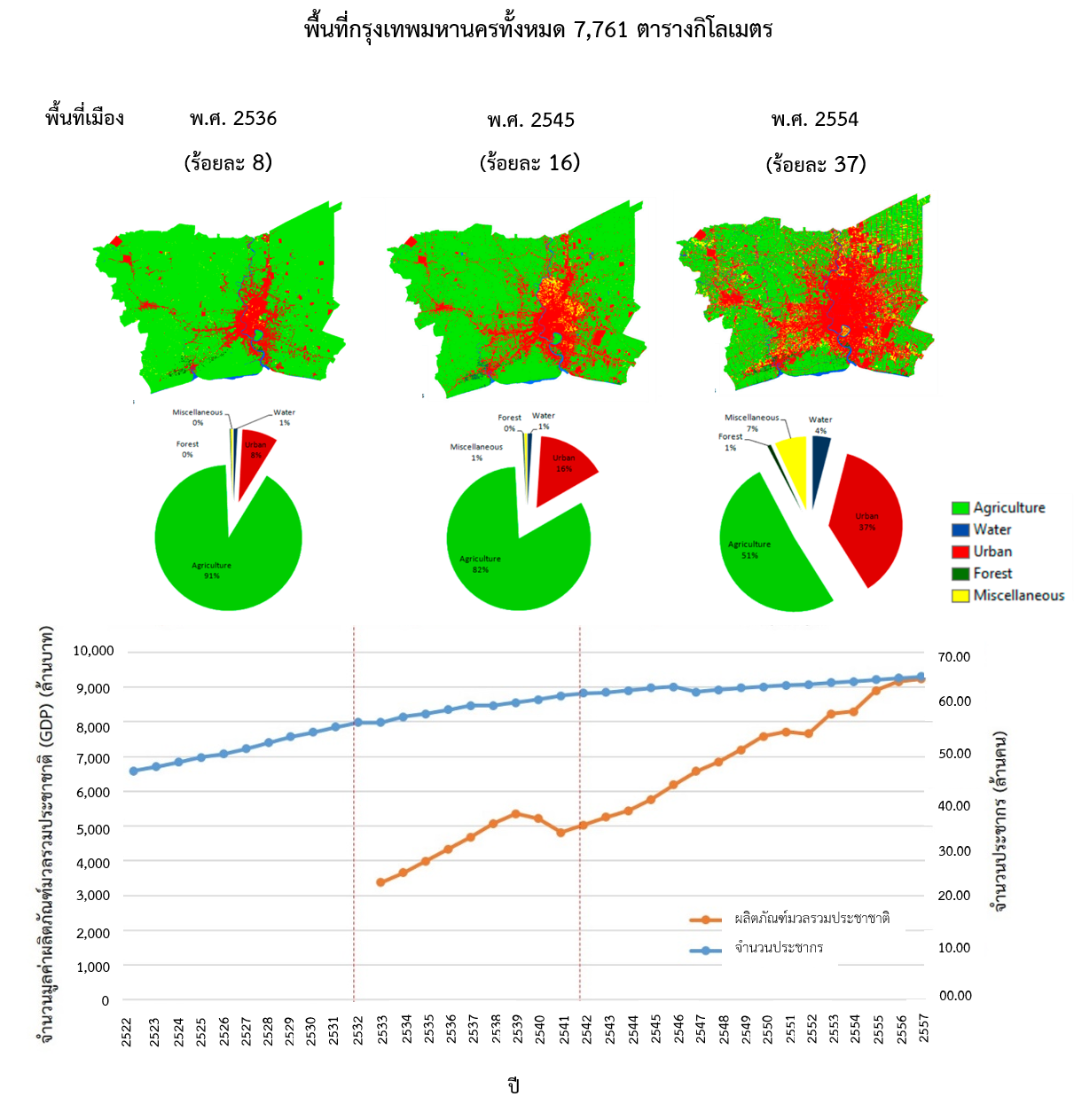The Study on Relationship between Social Capital and Site Potential: Case study of Thakhlong Municipality, Pathumthani
Main Article Content
Abstract
The importance of social capital has been changed according to the movement of urban development in term of socio-economic and environmental aspects. Physical transformation of urban development directly affected people living, particularly travelling pattern and social interactions. Furthermore, unplanned and insufficient development of urban infrastructure has also caused considerable impacts on daily activities. This study selected Tha-Khlong municipality, Pathumthani province as a case study for an analysis of the relationship between the social capital factors and the site potential factors. The finding of non-physical aspects would indicate social challenges that arise in the study area. Moreover, spatial analysis through the Geographic Information System (GIS) would show spatial allocations of infrastructure services and level of social dimensions. Next statistical technique of cluster analysis could address eight groups of clustering that present of socio-economic profiles of lifestyles in the study area. Their different behaviors could explain current challenges and opportunities. Finally, land use planning guidelined enhancing social interaction and social capital improvement would be mentioned.
Downloads
Article Details

This work is licensed under a Creative Commons Attribution-NonCommercial-NoDerivatives 4.0 International License.
All material is licensed under the terms of the Creative Commons Attribution 4.0 International (CC-BY-NC-ND 4.0) License, unless otherwise stated. As such, authors are free to share, copy, and redistribute the material in any medium or format. The authors must give appropriate credit, provide a link to the license, and indicate if changes were made. The authors may do so in any reasonable manner, but not in any way that suggests the licensor endorses you or your use. The authors may not use the material for commercial purposes. If the authors remix, transform, or build upon the material, they may not distribute the modified material, unless permission is obtained from JARS. Final, accepted versions of the paper may be posted on third party repositories, provided appropriate acknowledgement to the original source is clearly noted.
References
Campbell, J. F., & Shin, M. (2012). Geographic information system basics (v. 1.0). Retrieved from https://2012books.lardbucket.org/pdfs/geographic-information-system-basics.pdf.
Kang, B. (2006). Effects of open spaces on the interpersonal level of resident social capital: A comparative case study of urban neighborhoods in Guangzhou, China. Unpublished PhD. Texas A& M University.
Lisnund, N. (2016). Guidelines on promotion of the public space potential in the old districtof Nakhon Ratchasima city. Journal of Architectural/Planning and studies (JARS), 13(2), 99-122.
Wood, L. Shannon, T., Bulsara, M., Pikora, T., McCormack, G., & Giles-Corti, B. (2008). The anatomy of the safe and social suburb: An exploratory study of the built environment, social capital and residents’ perceptions of safety. Health & Place, 14(1), 15-31.
Bank of Thailand. (2015). Annual report 2015, Pursuing sustainable economic well-being. Retrieved from https://www.bot.or.th/Thai/ResearchAndPublications/Report/DocLib_/Report_2558.pdf.
Carmona, M., Tiesdell, S., Heath, T., & Oc, T. (2003). Public places urban spaces, The dimensions of urban design (2nd ed.). Oxford, UK: Architectural Press.
Department of Provincial Administration. (2014). Population and housing statisitc-Age population ranking. Retrieved April 25, 2014 fromhttp://stat.dopa.go.th/stat/statnew/upstat_age.php.
Fistola, R. (2011). The unsustainable city. Urban entropy and social capital: the needing of a new urban planning. Procedia Engineering, 21, 976-984. Retrieved from https://www.sciencedirect.com/science/article/pii/S1877705811049368.
Grootaert, C., & Bastelaer, T. (2002). Understanding and measuring social capital: A synthesis of findings and recommendation from the social capital initiative (Social Capital Initiative Working Paper No. 24). Washington, USA.: The World Bank.
Iamtrakul, P., & Klaylee, J. (2018). Sustaining road safety for campus town development: Case study ofThammasat University (Rangsit Campus). Journal of Architectural/Planning and studies (JARS), 15(1), 49-67.
Iamtrakul, P., Raungratanaamporn, I., & Shinpiriya, P. (2017). Framework of planning and policy analysis for Transit Oriented Development (TOD) towards sustainable urban development. Journal of Architectural/Planning and studies (JARS), 14(1), 95-122.
Li, k., & Lin, B. (2017). Economic growth model, structural transformation, and green productivity in China. Applied energy, 187, 489-500. Retrieved from https://www.sciencedirect.com/science/article/pii/S0306261916317068.
Linn, R. L. (2001). Educational measurement (The American Council on Education). USA.: Macmillan.
Morrison, T. (2003). Staff supervision in social care. Ashford Press: Southampton.
Office of the National Economic and Social Development Board. (1961). The national economic and social development plan (The first plan (1961 - 1966): Phase 1). Bangkok, Thailand: Authors.
Office of the Royal Society. (2003). The Royal Institute Dictionary [RID], B.E. 1999. Bangkok: Nanmeebooks publication.
Office of Transport and Traffic Policy and Planning. (2004). Strategic planning (2013-2016), Office of Transport and Traffic Policy and Planning. Retrieved from http://www.otp.go.th/uploads/files/1472182543-fqich-0wa0i.pdf.
Poomchalit, W., & Suzuki, K. (2018). A Study of the importance of personal interests concerning on urban planning: Case studies in Kyoto City, Japan. Journal of Architectural/Planning and studies (JARS), 15(1), 17-34.
Putnam, R. (1993). The prosperous community: Social capital and public life. The American Prospect,13, 35-42. Retrieved from http://prospect.org/article/prosperous-community-social-capital-and-public-life.
Sanyawiwat, S. (1999). Thai indigenous knowledge. Bangkok: n.d.

